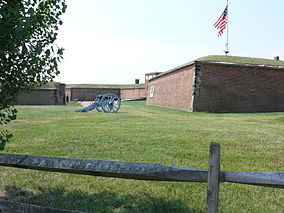Ft. McHenry
| Fort McHenry National Monument | |
|---|---|
|
IUCN category V (protected landscape/seascape)
|
|
 |
|
 |
|
| Location | Baltimore, Maryland, USA |
| Coordinates | 39°15′47″N 76°34′48″W / 39.26306°N 76.58000°WCoordinates: 39°15′47″N 76°34′48″W / 39.26306°N 76.58000°W |
| Area | 43.26 acres (17.51 ha) |
| Authorized | March 3, 1925 |
| Visitors | 641,254 (in 2011) |
| Governing body | National Park Service |
| Website | Fort McHenry National Monument |
Fort McHenry, in Baltimore, Maryland, is a historical American coastal star-shaped fort best known for its role in the War of 1812, when it successfully defended Baltimore Harbor from an attack by the British navy from the Chesapeake Bay September 13–14, 1814. It was first built in 1798 and was used continuously by U.S. armed forces through World War I and by the Coast Guard in World War II. It was designated a national park in 1925, and in 1939 was redesignated a "National Monument and Historic Shrine,"
During the War of 1812 a storm flag (17 by 25 feet (5.2 m × 7.6 m)) was flown over Fort McHenry during the bombardment. It was replaced early on the morning of September 14, 1814 with a larger garrison flag (30 by 42 feet (9.1 m × 12.8 m)). The larger flag signaled American victory over the British in the Battle of Baltimore. The sight of the ensign inspired Francis Scott Key to write the poem "Defence of Fort M'Henry" that was later set to the tune "To Anacreon in Heaven" and become known as the "Star Spangled Banner", the national anthem of the United States.
Fort McHenry was built on the site of the former Fort Whetstone, which had defended Baltimore from 1776 to 1797. Fort Whetstone stood on Whetstone Point (today's residential and industrial area of Locust Point) peninsula, which juts into the opening of Baltimore Harbor between the Basin (today's Inner Harbor) and Northwest branch on the north side and the Middle and Ferry (now Southern) branches of the Patapsco River on the south side.
...
Wikipedia
